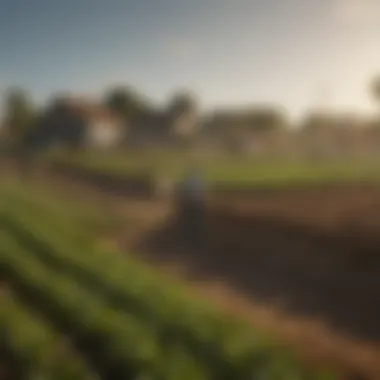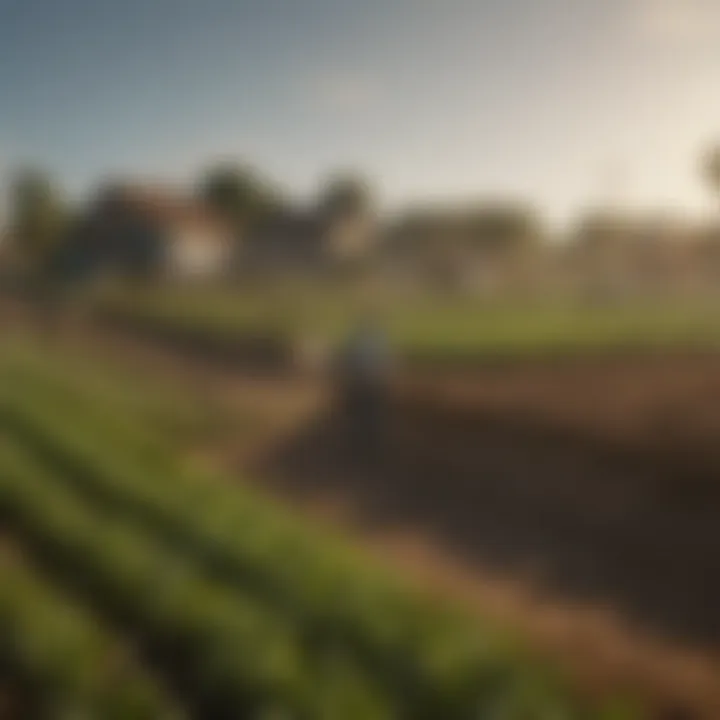Examining the Unsustainable Development Report's Impact on Agriculture


Intro
The unsustainable development report has sparked a necessary dialogue in various circles, particularly within the agricultural sector. Understanding the implications of this report is crucial for farmers, agronomists, and policymakers alike. This landscape is changing rapidly; hence, a thorough examination of the challenges faced by agriculture in light of these developments is imperative. This article will delve into the intricacies of the report, highlight various factors contributing to unsustainability, and explore the repercussions for the agricultural community and ecosystem.
Overview of the Topic
Definition and Importance
At its core, unsustainable development refers to practices that compromise the ability of future generations to meet their needs. In agriculture, this manifests through over-farming, resource depletion, and poor land management. Recognizing what this means for our food systems is critical. Agriculture sits at the crossroads of environmental sustainability and economic viability, making it a focal point for these discussions.
Integrating sustainability into agriculture is not just a trend but a necessity. As the global population grows, the demand for food increases, putting pressure on already strained resources.
Current Trends
Recent years have seen a shift towards more responsible farming practices. Farmers are beginning to adopt techniques that support sustainability, like crop rotation and organic farming. Additionally, technology has changed the way we approach agriculture. Drones and precision farming tools, for instance, are helping optimize yields while minimizing environmental impact. This movement, however, faces many hurdles, and awareness of the existing challenges is paramount.
Key Techniques and Practices
Step-by-Step Guide
For those in the agricultural sector looking to pivot to sustainable practices, here are some fundamental steps to get started:
- Assess Current Practices: Take an honest look at your existing approach. What are the areas causing the most strain on resources?
- Research Sustainable Methods: Engage with case studies from successful farmers who have adopted sustainable techniques. Learn from their experiences.
- Implement Changes Gradually: Start small. Experiment with one crop or practice before expanding.
- Monitor and Adjust: Keep track of your progress. What works? What doesn't? Adapt as needed.
Tools and Equipment Needed
Switching to sustainable practices often requires specific tools. Here’s a brief list to get going:
- Soil Moisture Sensors: To monitor soil health and maintain proper irrigation.
- Composting Bins: For creating nutrient-rich soil amendments.
- Cover Crop Seeds: To prevent soil erosion and improve fertility.
Challenges and Solutions
Common Obstacles
Navigating the transition to sustainable practices is not without difficulties. Some common challenges include:
- Financial Constraints: The initial investment for new tools or methods can be daunting.
- Knowledge Gaps: Many farmers may not be aware of sustainable practices or how to implement them.
- Market Resistance: There is often pushback from consumers accustomed to traditional methods.
Innovative Solutions
Addressing these challenges calls for creativity and collaboration. Here are some suggested solutions:
- Financial Support Programs: Government and non-profit organizations can provide subsidies or grants.
- Education and Training Workshops: Institutions can offer resources and support to build knowledge in sustainable practices.
- Community Supported Agriculture (CSA): This model encourages consumers to buy directly from farmers, often supporting local, sustainable practices.
"Transitioning to sustainable agricultural practices may be challenging, but the benefits for both the environment and the economy make it a worthwhile endeavor."
As the farming sector grapples with unsustainable practices highlighted in the report, the way forward lies in fostering dialogue and innovation. Integrating sustainable techniques is not just a catchphrase; it's an essential evolution in how we think about and engage with agriculture.
Understanding Unsustainable Development
Understanding the concept of unsustainable development is crucial for grasping the wider implications it has on various sectors, particularly agriculture. In an age where global issues such as climate change and resource depletion loom larger than ever, we can't afford to overlook how unsustainable practices create a ripple effect across ecosystems and communities. The agricultural sector is directly tied to these practices—after all, it relies heavily on natural resources like soil, water, and biodiversity, all of which are threatened by unsustainable methods.
By analyzing unsustainable development, we’re not speaking merely of decline or loss—there's a richer narrative here. We're talking about consequences that echo through generations, impacting farmers, agronomists, and entire communities. When unsustainable practices dominate the agricultural landscape, we risk more than short-term yield; we jeopardize food security and the livelihoods of those within the sector.
Moreover, understanding this concept helps illuminate the benefits that come from transitioning towards more sustainable methods. Farmers, for instance, could enjoy healthier soil and improved crop resilience. By considering sustainable alternatives, such as organic farming or permaculture practices, there's a potential for agricultural systems to thrive rather than merely survive.
Definition and Key Concepts
Unsustainable development refers to practices that compromise the ability of future generations to meet their own needs. At the core, this means utilizing resources beyond their natural capacity to regenerate. For agriculture, this encompasses a range of actions: excessive use of chemical fertilizers, monocropping, deforestation for arable land, and the mismanagement of water resources. These are only a handful of the practices that categorize a farming system as unsustainable.
Understanding key concepts like ecological footprints, crop diversity, and soil health is essential for anyone wishing to delve into this field. Recognizing these terms allows farmers to identify their current practices and understand their impacts—from the immediate effects on the land and water to the larger implications on climate.
Historical Context
The roots of unsustainable development in agriculture can be traced back to the industrialization of farming in the 20th century. This period saw a significant shift from traditional practices to a more mechanized approach, emphasizing efficiency over sustainability. The advent of synthetic fertilizers and pesticides, while initially boosting productivity, often led to soil depletion and exposure to toxic substances.
As consumer demand for cheap, mass-produced food increased, farmers were pushed further into intensive farming methods. The consequences became apparent as land quality diminished, water sources were drained, and biodiversity took a drastic hit. Providing historical context means we can better appreciate the complexities and challenges inherent to modern agricultural practices.
In fact, reflecting on history is more than just recounting facts; it serves as a warning and a guidepost. It reminds us that the choices made today cannot be made lightly.
Global Trends in Unsustainable Practices
As we look at global trends in unsustainable agricultural practices, the picture becomes increasingly concerning. For instance, there is a stark rise in the reliance on agrochemicals across various continents, particularly in developed nations. This trend leads not only to environmental harm but also raises questions about food safety and health implications for consumers.
Another significant trend is the increase in land conversion for agricultural use. Rainforests in the Amazon are cleared at alarming rates to make way for soybean plantations—a practice that disrupts entire ecosystems and contributes to climate change.
Changes in climate patterns themselves influence agricultural practices, pushing farmers to adapt unsustainable practices in a bid to cope. Here are some trends worth noting:
- Soil erosion due to intensive plowing and lack of crop rotation.
- Over-extraction of groundwater, which leads to depletion and salinization.
- Loss of biodiversity as farmers opt for cash crops over traditional varieties.
Addressing these trends isn't just an academic exercise; it’s imperative for future agricultural viability. Without proactive measures to pivot towards sustainability, the agricultural sector may find itself trapped in a cycle of diminishing returns, strained resources, and growing food insecurity.
"Farmers need to understand that farming is not just about producing food; it’s about maintaining the land for future generations."


In essence, the understanding of unsustainable development serves as the bedrock of our discussion, guiding us as we explore the role of agriculture and the need for sustainable practices moving forward.
The Role of Agriculture in Development
Agriculture serves as the backbone of countless economies around the world, weaving itself into the very fabric of development strategies. The relevance of this sector extends beyond mere food production; it encompasses economic prosperity, environmental stability, and social cohesion. Examining the role of agriculture in development is not just an academic exercise; it's fundamental to understanding how to forge a path towards sustainability.
Agricultural Dependence on Natural Resources
Natural resources are the lifeblood of agricultural systems. The land, water, and biodiversity are not just important; they are essential for farming practices. For many countries, especially developing ones, agriculture largely relies on these resources. Without clean water and robust soil, crop yields can dwindle, and that can spell disaster for both farmers and consumers.
- Soil Quality Issues: Soil degradation through erosion, nutrient depletion, and contamination affects not just the immediate land use but the future viability of agriculture. A farmer may have seen strong yields in the past, but over time, the relentless focus on high output can lead to diminishing returns.
- Water Scarcity: As populations expand and climate change alters rainfall patterns, access to water for irrigation has become a pressing concern. Many regions have witnessed a dramatic drop in water availability, calling for innovative methods of water management in agriculture. The traditional methods may no longer suffice, leading to a more concerted push for sustainable irrigation practices.
Economic Contributions of Agriculture
Agriculture is a critical component of economic structure, especially in developing nations where a large proportion of the populace relies directly on farming for their livelihood. The economic contributions can be viewed through various lenses:
- Job Creation: Circle back to the basics—farming creates jobs. From large agribusinesses to local farming cooperatives, the agricultural sector provides employment to millions. This is vital, especially in rural areas where job opportunities are scarce.
- Contribution to GDP: In many lower-income countries, agriculture comprises a sizable chunk of the gross domestic product (GDP). This highlights the ripple effect agriculture has on broader economic health. A thriving agricultural sector can help boost local economies through demand for goods and services associated with farming.
- Global Trade: Agriculture also plays a pivotal role in international trade. Many countries rely heavily on agricultural exports, which can bolster their economy significantly. For instance, coffee and cocoa are staples for many nations that depend on these products to bolster their economic stability.
Social Implications of Agricultural Practices
Beyond the economic metrics, the social implications of agricultural practices carry tremendous weight. The way agriculture is conducted affects food security, social equity, and community health.
- Food Security: Sustainable agricultural practices can enhance food security, reducing hunger and providing nutrition. Conversely, unsustainable methods can lead to food scarcity, creating a vicious cycle of poverty and malnutrition.
- Community Dynamics: Agriculture shapes social structures. Family farms may foster close-knitted communities, while industrial agriculture could lead to the alienation of farmers from their land and heritage. There's a need for a balanced approach that honors traditional practices while introducing innovative technologies.
- Cultural Heritage: Many communities have rich agricultural traditions that are more than just food production; they’re part of their cultural fabric. Preserving these practices should be a priority, as they enhance identity and can lead to more sustainable farming practices through indigenous knowledge.
"Agriculture is not just the cultivation of land; it is the cultivation of the lifeblood of society and history, weaving a tapestry that connects generations."
Understanding The Role of Agriculture in Development provides a broad overview of essential interconnections. It is foundational for addressing the challenges posed by unsustainable practices, allowing us to envision robust, resilience-oriented future strategies.
Analyzing Unsustainable Agricultural Practices
Agriculture sits at the crossroads of our global food systems and environmental health, making it essential to unravel the implications of unsustainable practices in this sector. This deep dive into agricultural methods that often undermine sustainability is necessary. Not only does it reveal the dangers of these practices, but it also elucidates the potential pathways for more responsible approaches that can benefit farmers and the environment alike.
By critically assessing practices like the overuse of chemical inputs, water mismanagement, and the impact of deforestation, we can begin to form a clearer picture of the challenges facing agriculture today. Understanding these facets will help in sculpting supportive policies and innovative strategies that align with the dual goals of food security and environmental preservation.
Overuse of Chemical Inputs
The reliance on heavy chemical inputs in agriculture stands out as a major contributor to various forms of environmental degradation. This habit, born out of an impulse for higher yields, often backfires, leading to a cascade of negative effects.
Impact on Soil Health
Chemical inputs have far-reaching consequences on soil health. When farmers consistently apply fertilizers and pesticides, they risk depleting the soil of its natural nutrients, leading to a condition often referred to as chemical saturation. This phenomenon compromises the organic matter that contributes to the soil's fertility, ultimately lessening its water retention ability.
Soils rich in organic material tend to thrive, providing a robust environment for beneficial microorganisms. The loss of this vitality can make it harder for crops to flourish over time. If soil health is diminished, the long-term productivity of the land is at stake, creating a cycle of dependency on increasingly potent chemical products that further exacerbate the problem.
"Healthy soil is the backbone of sustainable agriculture; its degradation is a direct threat to crop health and the environment."
Effects on Crop Yield
While using chemicals can yield immediate benefits in terms of productivity, it can also have a deleterious impact in the long run. High chemical usage not only leads to dependency but can also unhinge the delicate balance of ecosystem services that crops rely on. A minute oversight can lead to pests becoming resistant, resulting in a decline in crop yield.
Moreover, the possibility for chemical escarpment into nearby water systems can affect the quality of produce. Certain crops may grow in a nutritionally compromised environment, impairing their quality and minimizing their market value. Over time, farmers may find themselves in a paradox where their efforts to boost production through chemicals have led to diminishing returns.
Water Mismanagement
Water is the lifeblood of agriculture, and its mismanagement is nothing short of a travesty. In many places, irrigation practices reflect a disconnect from natural water cycles. Insufficient planning can lead to catastrophic outcomes for both the environment and agriculture.
Consequences of Irrigation Practices
Irrigation is meant to support agricultural endeavors, but when poorly managed, it can lead to severe soil salinity and waterlogged conditions. Too much irrigation saturates the soil, causing salts to accumulate and making it impossible for roots to absorb necessary nutrients. Consequently, plants may struggle to grow and yield produces that are subpar in both quantity and quality.
Additionally, reckless irrigation threatens local waterways. If water bodies are being drained beyond sustainable limits, entire ecosystems can fall out of balance, causing a ripple effect through the local food chain.
Water Scarcity Issues
Water scarcity is emerging as one of the most pressing issues of our age, targeting agricultural regions globally. Many rural areas face severe challenges, affecting crop production and food security. Increased competition for limited water resources often leads farmers to adopt more aggressive practices
While this may provide short-term relief, it puts strain on ecosystems, leading to depletion of groundwater and alteration of local aquifers. In the long run, these problems could limit water availability, forcing farmers into difficult choices that impact both their livelihoods and the environment.
Deforestation and Land Degradation
The trend of clearing forests for agricultural expansion has devastating impacts. Deforestation doesn't just eliminate biodiversity; it disrupts entire ecosystems. When forests are replaced with monoculture plantations or grazing land, the benefits of ecological balance are often exchanged for short-term economic gains.
The removal of trees takes away a vital buffer for soil against erosion and floods, further accelerating land degradation. Communities that rely on forest resources for sustenance find themselves squeezed as their environment diminishes.
By scrutinizing these unsustainable practices in agriculture, we illuminate the need for transformative adjustments. It's not merely about altering the methods of farming; it concerns rethinking our relationship with nature, technology, and what sustainability genuinely entails in a world that requires effective stewardship.
Environmental Consequences of Unsustainable Practices
Understanding the environmental consequences of unsustainable agricultural practices is crucial for comprehending the broader impact of agricultural activities on our ecosystems. Unsustainable methods not only endanger the land but also severely affect biodiversity, contribute to climate change, and exacerbate soil degradation. These elements intersect, leading to a complex web of challenges that need urgent attention.
Biodiversity Loss
The loss of biodiversity is one of the most pressing environmental consequences tied to unsustainable agriculture. When farmers rely heavily on monocultures, it reduces the variety of plants and animals in agricultural landscapes. This reduction means fewer pollinators, pests, and beneficial organisms that sustain ecosystem balance. Moreover, the use of chemical pesticides and fertilizers can lead to toxicity in soil and water bodies, further depleting local species and habitats.
For example, the extensive use of genetically modified crops to increase yield might seem beneficial from a production standpoint. However, it often results in a decline of native crop varieties and local fauna that have adapted to traditional agricultural practices. In turn, this loss threatens food security as plants and animals that could withstand local climate changes or pest outbreaks are lost.


Climate Change Impacts
Climate change impacts are inextricably linked to unsustainable farming practices, making it a critical issue to consider. Unsustainable methods contribute significantly to greenhouse gas emissions, which worsen global warming and its associated effects on agriculture.
Contribution of Agriculture to Greenhouse Gases
Agricultural activities are large contributors to greenhouse gases such as carbon dioxide, methane, and nitrous oxide. Livestock farming, for instance, produces methane through enteric fermentation, a process where microorganisms break down food in animal digestive systems. According to studies, methane is over twenty times more potent than carbon dioxide in trapping heat in the atmosphere over a 100-year period.
Additionally, practices such as deforestation for arable land release substantial amounts of carbon stored in trees and soil. The key characteristic of this issue is its immediacy – the emissions generated are adding to climatic changes that impact farming conditions, threatening crop yields and food production.
The unique feature of agricultural contributions to greenhouse gases lies in its duality: while agriculture is a significant source of emissions, it also stands to be one of the most impacted sectors by climate change. The necessity for addressing this contradiction is evident, as adaptation and mitigation strategies become essential for sustainable development.
Adaptation Strategies
Adaptation strategies are critical in countering the adverse effects of climate change on agriculture. These can involve altering farm management practices, adopting technology that enhances resilience, and utilizing more sustainable crop varieties. The key characteristic of adaptation strategies is their focus on increasing the resilience of agricultural systems to climatic shocks, allowing farmers to adjust to changing conditions.
A noteworthy unique feature of adaptation strategies is the integration of local knowledge and traditional practices with modern science. This combination can enhance community ownership of the processes involved and create solutions that are tailored specifically to local conditions. However, challenges persist; not all farmers have equal access to resources for adopting these strategies, leading to potential inequalities in agricultural resilience.
Soil Erosion and Degradation
Soil erosion and degradation fundamentally undermine the integrity of natural ecosystems and agricultural productivity. Key factors contributing to this are over-reliance on chemical fertilizers, inadequate crop rotation, and excessive tillage practices. With the topsoil eroded, the remaining soil loses its nutrients and structure, hurting crops’ ability to thrive.
If we’re to maintain food security in the face of climate variability, it’s paramount that strategies are employed to protect our soil resources. This highlights an urgent need for the agricultural sector to shift towards more sustainable practices that prioritize soil conservation. Techniques like cover cropping, reduced tillage, and organic fertilization can not only halt degradation but also bolster soil fertility over time.
"Protecting soils is crucial for ensuring food security and addressing climate change."
In essence, the environmental consequences of unsustainable agricultural practices paint a stark picture for the future of agriculture. If not addressed, these consequences will reverberate through ecosystems, economies, and communities in ways that are both profound and lasting.
The Sociopolitical Dimension
The sociopolitical dimension plays a crucial role in understanding the implications of the unsustainable development report on agriculture. At its core, this dimension encompasses the interplay between agricultural policies, international organizations, and grassroots movements. Each element is pivotal for enabling farmers to navigate the complexities of sustainable practices and ensuring that their voices are heard in the broader dialogue on agriculture and sustainability.
Policies Affecting Agricultural Sustainability
Government policies are a cornerstone in shaping the landscape of agricultural sustainability. These dictate not only how resources are managed but also influence the social and economic environment in which farmers operate. Policies can either encourage sustainable practices or perpetuate harmful methods, depending on how they are framed.
For instance, subsidies for chemical fertilizers may lead to short-term gains for farmers, but at the cost of long-term soil health. On the other hand, incentives for organic farming can promote practices that benefit the environment and yield healthier crops.
To drive meaningful change, policymakers must consider:
- Regulations on chemical use: Limiting access to harmful substances while promoting alternatives.
- Sustainability benchmarks: Setting clear guidelines for what it means to farm sustainably.
- Support programs for transition: Helping farmers shift from unsustainable to sustainable practices through funding and education.
Emphasizing policies that align closely with environmental goals, while considering the unique challenges that farmers face, can lead to a more resilient agricultural sector.
Role of International Organizations
International organizations have a profound impact on agricultural practices across borders. They serve as platforms for knowledge exchange and funding for sustainability initiatives. Well-known organizations like the Food and Agriculture Organization (FAO) and the World Bank play crucial roles in shaping agricultural policy on a global scale.
Through various programs, these organizations can:
- Disseminate research and best practices: Ensuring that farmers have access to the latest techniques and innovations.
- Facilitate funding for sustainable projects: Providing financial resources to implement better practices in developing regions.
- Encourage cross-border collaborations: Promoting partnerships between countries to share solutions and technologies that work effectively in different contexts.
By addressing international inequities in agricultural development, these organizations can help create a more balanced landscape for farmers around the world.
Grassroots Movements and Advocacy
Grassroots movements have the power to bring change from the ground up. Often originating from the communities most affected by unsustainable practices, these movements raise awareness about the impacts of current agricultural methods on both the environment and society.
Farmers united in advocacy often push for:
- Local policy change: Campaigning for legislation that prioritizes sustainability in local agricultural practices.
- Community education: Providing training sessions on sustainable farming techniques and emphasizing the importance of environmental stewardship.
- Networking opportunities: Connecting farmers with like-minded individuals and organizations to share resources and support each other.
These movements remind us that change often starts small, with local communities fostering a bigger impact on policy and practices at larger scales.
Case Studies in Unsustainable Development
Understanding the various case studies in unsustainable development is crucial for both recognizing past mistakes and planning for a sustainable future in agriculture. These case studies provide tangible examples of agricultural practices that have faltered due to lack of foresight or unsustainable methods. Their analysis illuminates the direct consequences of poor planning and resource management, essential knowledge for farmers and policymakers who aim to avoid similar pitfalls.
Examining real-world applications helps grasp the nuances of agricultural initiatives, whether successful or not. By analyzing these cases, we uncover key lessons, opportunities for improvement, and inspire innovative solutions to current challenges. Here, we look at both failed agricultural initiatives that highlight what went wrong and successful adaptations that offer a beacon of hope.
Failed Agricultural Initiatives
One cannot truly learn without understanding past failures. Various agricultural projects worldwide have been hailed as brilliant strategies but ended in catastrophe.
Take, for instance, the case of the Green Revolution in certain countries. While it introduced high-yielding varieties of crops, the reliance on chemical fertilizers and water-intensive practices without considering the long-term effects led to severe soil degradation and water scarcity in the region. In countries like India, increased crop yields came at the cost of ecological health, affecting soil microbiomes and local biodiversity.
Furthermore, subsidized monoculture farming schemes often encourage farmers to plant a single crop year after year, resulting in depleted soils unable to sustain diverse crop systems. This over-reliance on a narrow range of species can render agricultural systems highly vulnerable to pests and diseases. The impacts are twofold: not only do these practices harm the land and ecosystems, they also jeopardize the livelihood of farmers who are left with fewer choices in crop rotation and market viability.
Some of the key takeaways from these failures include:
- The importance of biodiversity in farming systems to curtail vulnerabilities.
- Need for sustainable practices that prioritize soil health and water management.
- Lessons in policy making that consider ecological impact rather than short-term gains.
Successful Adaptations in Farming
On the flip side, there are numerous success stories in agricultural adaptations that underscore resilience and innovation. Take the example of agroecology, which emphasizes ecological principles in farming. Farmers who have adopted these methods have not only observed improved soil health but also increased crop diversity, leading to more stable yields.


In Brazil, smallholder farmers utilizing mixed cropping techniques have reported enhanced soil fertility, reduced disease incidence, and improved economic outcomes. By planting multiple species together, they create a symbiotic environment that bolsters the agricultural ecosystem. This approach not only improves their food security but also contributes to the local biodiversity that is essential for a healthy agricultural landscape.
Moreover, community-supported agriculture (CSA) models have been making waves in local food systems. Farmers working with direct-to-consumer sales reduce dependence on mass-market pressures and can focus on sustainable farming practices that prioritize local conditions. These successful adaptations provide a roadmap not only for farmers but for policymakers, highlighting the need to support systems that encourage ecological balance and community interaction.
In summary, analyzing failed and successful agricultural initiatives reveals a wealth of insights. Understanding why certain methods flounder and others flourish provides valuable context for anyone looking to foster sustainable practices in agriculture. To truly advance, we must keep learning from the past while embracing innovative solutions that stand the test of time.
Pathways Toward Sustainability
The quest for sustainability in agriculture isn't just a passing trend; it's becoming a necessity as the pressures of climate change and resource scarcity compound. Understanding pathways toward sustainability means recognizing innovative practices that can lead to healthier ecosystems, economic resilience for farmers, and food security for societies. These pathways, when properly mapped out, can deliver a host of benefits, such as soil regeneration, biodiversity enhancement, and reduced reliance on chemical inputs.
Addressing sustainability involves not just the adoption of new techniques but also a shift in mindset. Farmers can no longer view agriculture as merely extracting resources; the focus must shift toward producing food in harmony with nature. Such a perspective is integral for cultivating long-term agricultural viability.
Innovative Farming Techniques
Precision Agriculture
One of the hallmarks of modern commitment to sustainability is precision agriculture. This approach hinges on data-driven decision-making. By utilizing technologies like GPS and IoT (Internet of Things), farmers can make informed choices about where to apply fertilizers and water, cutting down on wastage. The key characteristic of precision agriculture is its ability to optimize field-level management regarding crop farming.
This technique has emerged as a favored choice among progressive farmers for its efficiency and potential cost savings. Imagine knowing precisely how much moisture a section of your fields needs, rather than relying on broad estimates. Farmers are not just shooting in the dark; they have actual data guiding their practices.
However, precision agriculture does come with challenges. The initial investment in technology can be daunting, and there is a learning curve involved when it comes to interpreting data. Yet, the long-term benefits— like increased yield and reduced environmental impact—make it a favorable strategy in the sustainability dialogue.
Agroecology
Agroecology offers another promising path for sustainable farming. This method emphasizes the integration of ecological principles into farming. It’s about more than just growing crops; it’s about crafting an entire ecosystem that supports diverse plant and animal life. The key characteristic of agroecology is its focus on the relationship between food production and the environment, promoting biodiversity at every level.
Agroecology is becoming a popular choice for many farmers as it aligns agricultural practices with natural cycles. Its unique feature lies in the reliance on local inputs and traditional knowledge, which not only helps in restoring land health but also fosters community resilience.
That said, moving entirely to agroecological practices isn't without its downsides. Transitioning may require more effort and time compared to conventional methods, and the results can sometimes be variable based on environmental conditions. Nevertheless, agroecology's emphasis on sustainability shows great promise for the future of agriculture.
Policy Recommendations
To support the shift toward sustainable practices, policies should be put in place that incentivize farmers to adopt techniques like those mentioned above. This could be in the form of subsidies for precision farming technology or grants for farmers who wish to transition to agroecological methods. Furthermore, creating policies that encourage the sharing of knowledge and resources among farmers can help foster a sense of community in the effort toward sustainability.
Collaborative Efforts in the Sector
Collaboration is the name of the game when it comes to agriculture. Various stakeholders—governments, NGOs, and agricultural communities—need to work hand in hand. Through collaborative efforts, resources can be pooled, ensuring a more robust approach to tackling sustainability challenges. For instance, partnerships between educational institutions and farming communities can facilitate training programs that help farmers acquire new, sustainable techniques.
Efforts like these create a synergistic effect, ultimately increasing the resilience of agricultural systems against environmental stressors. By working together, the agricultural sector can enhance its ability to adapt and thrive in a rapidly changing world.
The Role of Education in Sustainability
Education serves as a cornerstone in the pursuit of sustainable agriculture. It is through effective training and knowledge transfer that farmers can adopt better practices, ultimately impacting not only their productivity but also the environment. By nurturing a culture of sustainable practices, educational entities can equip the agricultural community with necessary tools and insights to navigate the challenges posed by unsustainable development. Addressing this aspect helps bridge the gap between traditional farming methods and modern, sustainable alternatives.
An educated farmer is better positioned to make informed decisions regarding the use of resources, pest management, and crop diversification. Knowledgeable individuals are more adept at integrating sustainable approaches into their practices. For instance, the understanding of soil health and its relation to crop yield can steer farmers towards utilizing organic inputs instead of harmful chemicals. Furthermore, education ignites innovation in agricultural technologies, paving the way for healthier ecosystems and enhanced food security.
Training Programs for Farmers
Training programs tailored for farmers play a vital role in enhancing agricultural sustainability. These programs can range from hands-on workshops to comprehensive courses covering essential topics such as soil management, climate resilience, and efficient water usage. Through practical sessions, farmers gain exposure to advanced techniques such as bio-intensive farming or permaculture, all aimed at improving productivity without over-exploiting resources.
- Key elements of training programs include:
- Hands-on learning: Workshops that promote active participation enhance understanding.
- Local knowledge integration: Programs that incorporate indigenous farming wisdom help bridge cultural practices with modern methods.
- Sustainable technology exploration: Training entails familiarization with technologies that reduce labor intensity while boosting yields.
Moreover, collaborative initiatives with local agricultural extension services can ensure that training is relevant to the unique challenges farmers face in specific regions. When farmers see the tangible benefits of implementing what they learn, it reinforces their commitment to sustainable practices.
Educational Institutions’ Contributions
Educational institutions contribute significantly to advancing agricultural sustainability by conducting research and fostering innovative practices. Universities and colleges not only offer formal education in agricultural sciences but also engage in crucial research that drives the sector forward. Their efforts can focus on developing sustainable crops, pest-resistant varieties, and techniques tailored for specific climates.
Unyiversity collaborations often yield:
- Research initiatives that address local agricultural challenges while exploring novel sustainable practices.
- Internships and fieldwork opportunities that place students in real-world farming contexts—enhancing their insights into contemporary agricultural issues.
- Outreach programs that directly involve the community, ensuring awareness and accessibility to sustainable practices.
Institutions working together with farmers help formulate policies and provide data-driven insights critical for regulatory decisions. This path encourages an agricultural landscape that increasingly prioritizes sustainability, fostering a mindset shift in the farming community.
"Education is the most powerful weapon which you can use to change the world." – Nelson Mandela
By engaging in these educational efforts, both training programs and institutions alike play a crucial role in sculpting the future of agriculture where sustainability is not just an aspiration but a practical approach ingrained in everyday practices.
The Future of Sustainable Agriculture
The future of sustainable agriculture stands at a crucial juncture where innovation and environmental responsibility intersect. As the pressures of climate change, population growth, and resource depletion mount, the agricultural sector must evolve to meet these challenges head-on. This evolution is not just a luxury; it’s a necessity for maintaining food security and preserving the planet for future generations.
By embracing sustainable practices, farmers can enhance productivity while reducing their ecological footprint. Focusing on renewable resource usage, optimized farming techniques, and resilient crop varieties becomes imperative. These strategies don’t merely aim to maintain current outputs; they strive to improve them while ensuring that farming does not compromise the very ecosystems that support it.
Technological Innovations
In recent years, technological advances have began to reshape the landscape of sustainable agriculture. Tools ranging from precision farming technologies to biotechnological advancements pave the way for more efficient and responsible agricultural practices.
- Precision Agriculture: Utilizing data analytics, GPS technology, and remote sensing, precision agriculture allows farmers to analyze and manage variability in their fields. This helps maximize outputs while minimizing inputs, like water and fertilizers. By making informed decisions, farmers can decrease waste and enhance crop quality.
- Biotechnology: Genetically modified organisms (GMOs) may seem controversial, but they can offer significant benefits, such as improved resistance to pests and climate variability. Through careful management, these innovations can enhance yield and reduce the need for chemical pesticides, which in turn improves soil health.
- Vertical Farming: Urban areas increasingly adopt vertical farming techniques, utilizing controlled environment agriculture to produce food in compact spaces. This not only ensures fresher products but also reduces transportation emissions, making it an environmentally sustainable option.
"The adoption of innovative technology in agriculture holds the key to meeting the food demands of a growing population while safeguarding the environment."
Exploring Alternative Food Systems
As part of the journey towards sustainability, alternative food systems are gaining traction. These systems challenge conventional agriculture and offer new paradigms that can align better with ecological and social goals.
- Community Supported Agriculture (CSA): This model fosters a direct relationship between farmers and consumers. Community members purchase shares of the harvest in advance, providing farmers with essential capital while ensuring consumers receive fresh and locally sourced food.
- Organic Farming: This method emphasizes the use of natural inputs and crop rotations, thereby maintaining and enhancing soil fertility. Organic practices often encourage biodiversity and eliminate toxic synthetic chemicals, benefiting both the environment and health.
- Local and Seasonal Eating: Advocating for local food systems helps reduce carbon footprints associated with long-distance transportation and storage. Eating seasonally not only supports local economies but also encourages sustainable farming practices.
The path forward lies in collaboration among stakeholders — from farmers to policymakers — focusing on shared objectives that seek to balance out productivity with sustainability. By fostering dialogue, education, and innovative approaches, we can carve out a future for sustainable agriculture that is both viable and equitable.



